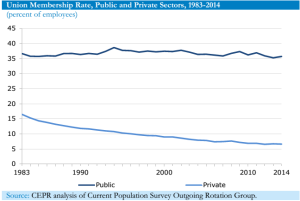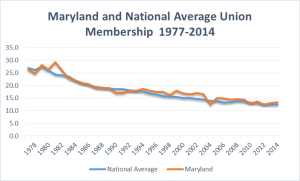State of Working Maryland: Unionization Up Slightly in Maryland
Unionization Up Slightly in Maryland
The number of unionized workers in Maryland increased slightly over the past year, despite a nationwide decline in the percentage of unionized workers. That’s good news since union membership is associated with higher wages for workers, which ultimately results in a higher standard of living for working families.
In today’s economy, where most of the benefits of the economic recovery have gone to the wealthiest Marylanders, quality jobs are more important than ever. State policymakers could give working families a boost by:
- Allowing workers to earn paid sick leave and giving workers who get tips from customers the same minimum wage as everyone else.
- Increasing enforcement and penalties for “wage theft,” such as failing to pay workers for overtime or paying them less than the minimum wage even though they are subject to it.
- Empowering working Marylanders to organize and advocate for themselves in their workplaces through policies that increase unionization. Historically, unionization has been one of the most reliable ways to create jobs that pay enough for workers to support their families.
In 2014, union membership in the U.S. declined to 11.1 % of workers, a historically low rate. The decline in unionization since the 1970’s has closely tracked the stagnation in wages and the American middle class standard of living in recent decades. These declining fortunes have come despite workers being more productive and a consistent rise in per capita Gross Domestic Product, a measure of the value of all goods and services produced in the country.
In Maryland, the total number of union members increased to 310,000, or by 0.3 %, reaching 11.9 %of the workforce. Maryland is one of only 21 states where union membership grew in 2014. Additionally, Maryland is among the top 40% of states in union membership. .
As of December 2014, private- and public-sector union membership were relatively even nationally, with 7.4 million in the private sector (which includes everyone employed by businesses) and approximately 7.2 million in the public sector (which includes teachers, firefighters and other public workers). But the reality is that private-sector workers are much less likely to have a union in their workplace.
The rise in total U.S. private-sector employment (up almost 2.6 million workers in 2014 or 2.3 %), has greatly outpaced union growth. Meanwhile, public-sector union membership has increased .04%. As illustrated below, 35.7 %of public sector workers belong to unions, while the private sector rate has fallen to 6.6 %.

As union membership declines, workers have less bargaining power in their efforts to gain better compensation and working conditions.

Today’s blog post is the first in our State of Working Maryland series looking at demographic and economic trends in the state. Previously, this has been an annual publication. This year we will instead publish occasional blogs and research briefs on topics affecting working families in Maryland.
